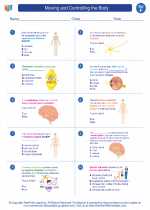Pituitary Gland
The pituitary gland is a small, pea-sized gland located at the base of the brain, just below the hypothalamus. It is often referred to as the "master gland" because it plays a crucial role in regulating various bodily functions by producing and releasing hormones.
Anatomy of the Pituitary Gland
The pituitary gland is divided into two main parts: the anterior pituitary (adenohypophysis) and the posterior pituitary (neurohypophysis). The anterior pituitary is composed of glandular tissue, while the posterior pituitary is made up of nervous tissue.
Functions of the Pituitary Gland
The pituitary gland is responsible for producing and secreting several important hormones that regulate growth, metabolism, reproduction, and other physiological processes. Some of the key hormones produced by the pituitary gland include:
- Adrenocorticotropic hormone (ACTH): Stimulates the adrenal glands to produce cortisol, a hormone involved in stress response and metabolism.
- Thyroid-stimulating hormone (TSH): Stimulates the thyroid gland to produce thyroid hormones, which regulate metabolism.
- Growth hormone (GH): Regulates growth, body composition, and metabolism.
- Prolactin: Stimulates milk production in the mammary glands.
- Antidiuretic hormone (ADH) and oxytocin: Produced in the hypothalamus and stored in the posterior pituitary, these hormones regulate water balance and uterine contractions during childbirth, respectively.
Regulation of Pituitary Function
The pituitary gland's hormone production and release are controlled by the hypothalamus, a region of the brain that sends signals to the pituitary through a network of blood vessels. These signals, in the form of releasing and inhibiting hormones, influence the pituitary gland's secretion of its own hormones.
Common Disorders of the Pituitary Gland
Disorders of the pituitary gland can lead to hormone imbalances and various health issues. Some common pituitary disorders include:
- Hyperpituitarism: Excessive production of pituitary hormones, often leading to gigantism or acromegaly (excessive growth of bones and tissues).
- Hypopituitarism: Insufficient production of pituitary hormones, resulting in growth failure, infertility, and other symptoms.
- Pituitary tumors: Abnormal growths in the pituitary gland that can cause hormone overproduction or compression of surrounding structures in the brain.
Study Guide
To study the pituitary gland, it's important to understand its anatomy, functions, and regulatory mechanisms. Here are some key points to focus on:
- Identify the location and anatomical parts of the pituitary gland.
- Understand the role of the pituitary gland as the "master gland" in hormone regulation.
- Memorize the names and functions of the hormones produced by the pituitary gland.
- Explore the feedback loops and regulatory mechanisms involved in controlling pituitary hormone secretion.
- Study common disorders associated with the pituitary gland and their effects on the body.
By mastering these concepts, you will gain a comprehensive understanding of the pituitary gland and its significance in maintaining physiological balance within the body.
.◂Science Worksheets and Study Guides Sixth Grade. Moving and Controlling the Body

 Worksheet/Answer key
Worksheet/Answer key
 Worksheet/Answer key
Worksheet/Answer key
 Vocabulary/Answer key
Vocabulary/Answer key
 Vocabulary/Answer key
Vocabulary/Answer key
 Vocabulary/Answer key
Vocabulary/Answer key
